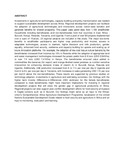| dc.description.abstract | Investments in agricultural technologies, capacity building and policy harmonization are needed to support sustainable development across Africa. Regional development projects can facilitate the adoption of agricultural technologies and innovations across nation‐state borders and generate benefits for shared prosperity. This paper uses panel data from 1,160 smallholder households including beneficiaries and non‐beneficiaries from five countries in East Africa ‐ Burundi, Kenya, Rwanda, Tanzania, and Uganda. From a pool of over 90 projects implemented over a span of 15 years, 23 regional projects are included in this study. The major economic benefits to smallholder participants are higher crop productivity and income, access to adaptable technologies, access to markets, higher livestock and milk production, gender equality, enhanced food security, resilience and capacity building for uptake and scaling up of future innovation platforms. For example, the adoption of low‐cost tissue culture banana by the beneficiaries increased their incomes by 15% in Rwanda while the adoption of appropriate land and water management technologies increased the potato yields from 2.8 tons (USD 2,840/ha) to over 7.5 tons (USD 7,410/ha) in Kenya. The beneficiaries ensured value added to commodities like bananas (for export) and orange‐fleshed sweet potatoes (a nutrition‐sensitive intervention for enhancing domestic intake of vitamin A) in Burundi, Kenya, Rwanda and Uganda. Additionally, milk production increased from 6 to 11 L per cow per day in Uganda and from 6 to 8 L per cow per day in Tanzania, with increases in sales generating USD 115 per cow per month above the non‐beneficiaries. These results are supported by previous studies on technology adoption, investments in agriculture and well‐being outcomes. Our findings with the higher farm income Difference‐in‐Differences (DiD) estimator for the female beneficiaries compared to male beneficiaries might have important implications for investing in regional development projects that will close the gender gap in agricultural productivity in Africa. Regional projects can also support post‐conflict development efforts for food security and peace in fragile contexts such as in Burundi. Our findings might serve as an input to the African Union's Comprehensive Africa Agriculture Development Programme, localization of the United Nations Sustainable Development Goals related to food security and agriculture in Africa and an input to monitoring, evaluation and learning. | en_US |

